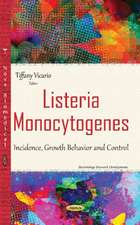Bacterial Metabolism: Springer Series in Microbiology
Autor Gerhard Gottschalken Limba Engleză Paperback – 8 oct 2012
| Toate formatele și edițiile | Preț | Express |
|---|---|---|
| Paperback (1) | 587.85 lei 6-8 săpt. | |
| Springer – 8 oct 2012 | 587.85 lei 6-8 săpt. | |
| Hardback (1) | 650.86 lei 6-8 săpt. | |
| Springer – 19 dec 1985 | 650.86 lei 6-8 săpt. |
Preț: 587.85 lei
Preț vechi: 691.59 lei
-15% Nou
Puncte Express: 882
Preț estimativ în valută:
112.52€ • 122.26$ • 94.58£
112.52€ • 122.26$ • 94.58£
Carte tipărită la comandă
Livrare economică 21 aprilie-05 mai
Preluare comenzi: 021 569.72.76
Specificații
ISBN-13: 9781461270034
ISBN-10: 1461270030
Pagini: 376
Ilustrații: XIII, 359 p.
Dimensiuni: 155 x 235 x 20 mm
Greutate: 0.53 kg
Ediția:Softcover reprint of the original 2nd ed. 1986
Editura: Springer
Colecția Springer
Seria Springer Series in Microbiology
Locul publicării:New York, NY, United States
ISBN-10: 1461270030
Pagini: 376
Ilustrații: XIII, 359 p.
Dimensiuni: 155 x 235 x 20 mm
Greutate: 0.53 kg
Ediția:Softcover reprint of the original 2nd ed. 1986
Editura: Springer
Colecția Springer
Seria Springer Series in Microbiology
Locul publicării:New York, NY, United States
Public țintă
ResearchCuprins
1 Nutrition of Bacteria.- I. Major and Minor Bioelements.- II. The Two Basic Mechanisms of ATP Synthesis.- III. Nutrients as Energy Sources.- IV. Growth Factor Requirements of Bacteria.- V. Summary.- 2 How Escherichia coil Synthesizes ATP during Aerobic Growth on Glucose.- I. Transport of D-Glucose into theE.coliCell.- II. Degradation of Glucose-6-Phosphate to Pyruvate via the Embden—Meyerhof—Parnas (EMP) Pathway.- III. Oxidative Decarboxylation of Pyruvate to Acetyl-Coenzyme A.- IV. Oxidation of Acetyl-CoA via the Tricarboxylic Acid Cycle.- V. The Formation of ATP in the Respiratory Chain.- VI. Summary.- 3 Biosynthesis ofEscherichia colsCells from Glucose.- I. Composition of E. coli Cells.- II. Assimilation of Ammonia.- III. Assimilatory Reduction of Sulfate.- IV. Biosynthesis of Amino Acids.- V. How Pentose Phosphates and NADPH are Formed.- VI. Ribonucleotides and Deoxyribonucleotides.- VII. Biosynthesis of Lipids.- VIII. Formation of Carbohydrates.- IX. Synthesis of Polymers.- X. The Requirement for an Anaplerotic Sequence.- XI. Summary.- 4 Aerobic Growth of Escherichia coli on Substrates Other Than Glucose.- I. Fructose and Lactose as Substrates.- II. Pentoses as Substrates.- III. Acetate, Pyruvate, and L-Malate as Substrates.- IV. Summary.- 5 Metabolic Diversity of Aerobic Heterotrophs.- I. The Different Mechanisms for the Uptake of Substrates.- II. The Entner-Doudoroff Pathway.- III. Sugar Degradation via the Pentose Phosphate Cycle.- IV. The Methylglyoxal Bypass.- V. Diversity in Energy Metabolism.- VI. Dissimilatory Reduction of Nitrate.- VII. Bacterial Bioluminescence.- VIII. Alternate Anaplerotic Sequences.- IX. Biosynthesis of Monomers and Polymers.- X. Summary.- 6 Catabolic Activities of Aerobic Heterotrophs.- I. Degradation of Polymers by Exoenzymes.- II. Growth with Amino Acids.- III. Growth with Organic Acids.- IV. Growth with Aliphatic Hydrocarbons.- V. Growth with Aromatic Compounds.- VI. Growth with C1Compounds.- VII. Incomplete Oxidations.- VIII.Plasmid-Encoded Catabolic Activities.- IX. Summary.- 7 Regulation of Bacterial Metabolism.- I. Regulation of Enzyme Synthesis by Induction and Repression.- II. Regulation of Enzyme Activity.- III. Summary.- 8 Bacterial Fermentations.- I. Alcohol Fermentation.- II. Lactate Fermentation.- III. Butyrate and Butanol-Acetone Fermentation.- IV. Mixed Acid and Butanediol Fermentation.- V. Propionate and Succinate Fermentation.- VI. Acetate Fermentation.- VII. Methane Fermentation.- VIII. Sulfide Fermentation (Desulfurication).- IX. The Anaerobic Food Chain.- X. Fermentation of Nitrogenous Compounds.- Xl. Summary.- 9 Chemolithotrophic and Phototrophic Metabolism.- I. Chemolithotrophic Metabolism.- II. Assimilation of CO2.- III. Phototrophic Metabolism.- IV. Summary.- 10 Fixation of Molecular Nitrogen.- I. Nitrogen-fixing Organisms.- II. Biochemistry of Nitrogen Fixation.- III. Regulation of Nitrogenase.- IV. Summary.- Further Reading.- Index of Organisms.














